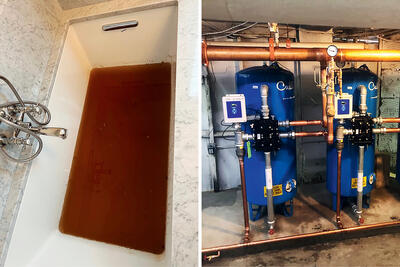Problem: Brown Water Is Coming Out of Our Taps!

Brown water (left) should be filtered at the point of entry to protect building systems.
As part of our ongoing Problem Solved series, Habitat spoke with Spencer Kraus, vice president at Fred Smith Plumbing & Heating.
Sometimes when people in New York City turn on their taps, brown water comes out. Is that a common problem?
It is. A lot of co-op and condominium buildings call us with brown water issues, especially right after a shutdown. It’s not sewage. The reservoirs that provide water to the city are located way upstate, and they use old plumbing pipes to get the water to your building. So as the water flows from the reservoirs, it picks up small particles of sediment and iron. They're found in the cold water mains. And then when they go into a building’s heating systems and hot-water systems, they expand and rust and turn the water brown.
What's the first step that you take as a plumber when you get a call like this?
Typically the first thing we do is we send a supervisor out there to take a look and find out where the brown water is. Usually the sediment is found in the hot-water supply lines. So we'll put a small cartridge filter on the main water line in the basement, and within an hour that will indicate the quality of the water coming into the building. If there’s a lot of sediment, the solution is to install a large depth filter media filtration device at the building water main in the basement. We've installed these depth filters in about 200 buildings, and if they’re properly maintained, they really clear up the problem. I'd say we’ve had almost a 100% success rate when it comes to clearing up the brown water issues that we've faced.
Tell me about the cost of these depth filters. Surely it depends on the size of the building, but what's the range?
We size these filtration devices based on the system’s demand. A townhouse is not going to need a depth filter. A small co-op may have one large water tank and need only one depth filtration device, while a very large building with 400 units might need three, four, maybe even five of these devices. So the range in cost could be between $8,000 up to $40,000, depending on your system’s demand.
(Like what you're reading? To get Habitat newsletters sent to your inbox for free, click here.)
Once the filters are in place, do they have a continuing healthy effect on the water circulating throughout the building?
Yes. It's not like the water that’s coming into the building is necessarily bad to drink. It's just that it's full of these iron particles and sediment that can negatively affect the building’s systems. And that's where the savings come in. That sediment goes to your boilers and your domestic hot-water heating system, your HVAC system, pumps, fire-suppression system, all the way up to your roof tank. All that sediment, whether it's the hot water or the cold water, will put wear and tear on the systems.
So the whole building is being negatively affected by these particles?
The whole building. The symptom of the problem is the brown water, but the solution is where the cold-water main enters the basement. And that's very important to know. Once you install these depth filters, they filter out 99.9% of all of the sediment in the incoming water — and that’s healthy for the building’s component parts. The upfront investment that a co-op or condo board makes is going to pay for itself over time in terms of reduced maintenance and breakdowns of the whole building's systems.